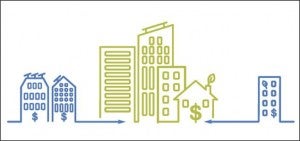 Energy efficiency is one of the fastest and most affordable ways to reduce harmful pollution. Why, then, aren’t we financing more energy efficiency upgrades?
Energy efficiency is one of the fastest and most affordable ways to reduce harmful pollution. Why, then, aren’t we financing more energy efficiency upgrades?
Well, simply put, there are quite a few barriers that must be addressed and broken down before energy efficiency skyrockets. Yes, there are already many buildings that have set the bar high for others to follow, but some investor and lender hesitancies still exist that we need to overcome.
Furthermore, the efficiency market cannot create itself. And it is currently stifled, despite investors’ eagerness to take part.
The problem, as the investment community sees it, is that there is no secondary market for energy efficiency loans. In other words, the pool of loans is currently not large enough to make these investments worthwhile for institutional investors. Furthermore, there is a lack of uniform standards for energy efficiency loans, limited data on loan and project performance and an insufficient pipeline of projects. There are also challenges to bringing efficiency to scale, namely:
- the split incentive—disconnect between the building owner and the residents, who actually pay the utility bill;
- utility disincentives—utilities generally make money by selling more energy, not by reducing wasted energy; and
- limited information available to consumers on their energy use.
Thus far, a patchwork of policies across the federal, state and local landscapes has not made a significant impact on overcoming these barriers and bolstering energy efficiency loans. Hence why EDF, through our On-Bill Repayment (OBR) and Investor Confidence Project (ICP) efforts, is working to break down some of these hurdles and accelerate the adoption of energy efficiency loans, which will, in turn, spur the creation of a secondary energy loan market.
To combat this delay, Ceres, along with twenty-nine investors and energy efficiency experts, came together to establish which policies will create the most bang for the buck in the efficiency market. The end result, the “Institutional Investor Energy Efficiency Policy Priorities Project” report, offers a unique perspective by addressing the barriers from the institutional investors’ point of view and assessing which policies will make the efficiency market more attractive. Because, at the end of the day, policy will drive progress.
The energy policies they identified are related to utility regulations, demand production and finance:
1) Utility regulatory policies would help eliminate the disincentives to increase energy efficiency by establishing business models that compensate utilities for energy efficiency upgrades based on performance, rather than electricity sales. The use of performance-based electricity rates relies on the utility’s ability to reasonably recover its costs for efficiency investments. Most states already allow energy efficiency cost recovery and more than half have some sort of decoupling mechanism—that is, a system which decouples revenue from sales (thereby encouraging, rather than discouraging, energy conservation). But removing the disincentive is only one component; providing an incentive to invest in efficiency, through policies such as Energy Efficiency Resource Standards (EERS), or to meet certain energy reductions goals is another matter. Currently twenty states are leading the effort with an EERS, and seven states have established energy efficiency goals.
2) Demand-producing policies would increase consumer demand for energy efficiency by measures including minimum appliance and equipment efficiency standards, energy efficient building codes and building energy use disclosure requirements. Not only do these policies aim to increase energy demand, but they also end up providing information for investors, such as setting baselines for efficient building performance and the most cost-effective, high-impact efficiency investments
3) Finance policies would help grow the pipeline of projects needed to move the energy efficiency market along. Innovative energy financing tools, such as On-Bill Repayment (OBR) and Property Assessed Clean Energy (PACE) are just two examples of ways to stimulate investor and customer interest.
While the barriers to getting more energy efficiency into the market are significant, they are by no means insurmountable. Clear and consistent policies, such as those outlined here, will help send signals to investors and customers about the substantial benefits a robust energy efficiency market has to offer, while at the same time lowering electric bills, making power more reliable and improving air quality.










